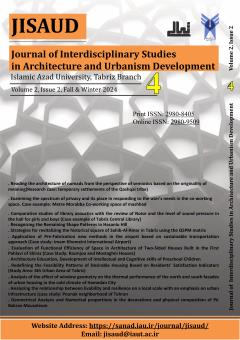Strategies for revitalizing the historical square of Sahib-al-Amar in Tabriz using the QSPM matrix
Subject Areas :
Samaneh Mahdinezhad
1
![]() ,
shahryar shaghaghi
2
,
shahryar shaghaghi
2
![]() ,
Seyedeh Roghayeh Rafiei BanialSadegh
3
,
Seyedeh Roghayeh Rafiei BanialSadegh
3
![]()
1 - Lecturer of Urban Planning Department, South Tehran Branch, Islamic Azad University, Tehran, Iran.
2 - Assistant professor and faculty member of architecture department, Shabestar branch, Islamic Azad University, Shabestar, Iran.(Corresponding Author)sh.shagagi@iaushab.ac.ir
3 - Bachelor's student in psychology, Shahre Ray Branch, Payame Noor University, Tehran, Iran.
Keywords: ", , ", SWOT", QSPM", Revitalization", Historical context", Quantitative Strategy", Sahib al-Amr Square",
Abstract :
Introduction: Historical districts in cities have played a significant role in shaping the urban life and cultural identity. Over time, various changes and developments have led to the deterioration of these areas. Utilizing prominent historical buildings as strengths and addressing environmental and physical challenges as weaknesses can greatly impact historical districts. The Sahib-al-Amr historical square in Tabriz, Iran, has historical significance but currently lacks its former identity and value. Therefore, the aim of the current research is to develop strategies for the revitalization of this historical square. Because revitalizing this square is crucial for preserving its historical and cultural value. The current physical challenges and visitor experience demand strategic planning and action for its revitalization. Methodology: The study focuses on the Sahib-al-Amr square in Tabriz, Iran, which holds a special place in the city's history. Dating back to the 14th century, the square has witnessed various transformations and architectural marvels, reflecting the influential periods it has experienced. The methodology employed in the research involved using the SWOT (Strengths, Weaknesses, Opportunities, Threats) matrix and QSPM (Quantitative Strategy Planning Matrix) to identify strengths, weaknesses, opportunities, and threats, and to develop practical strategies for revitalization. The research strategy falls within the adaptive range (WO), as determined by the QSPM matrix. Results: The results of the Internal Factor Evaluation (IFE) matrix reveal the significant impact of existing historical buildings as a strength and visual pollution and lack of security as the most significant weaknesses affecting the historical square. The External Factor Evaluation (EFE) matrix highlights the economic potential of the market as an opportunity, while concerns such as the absence of security due to broken windows and unauthorized encroachments are identified as the most threatening factors. The QSPM matrix found that priority 1 is creating arrangements for tourists in the historical complex, with a score of 7.23. Priority 2 is making rules to preserve historical buildings in the area, with a score of 7.20. Priority 3 is modernizing the use around the square and considering its historical role, with a score of 7.19. Priority 4 is adding nighttime activities, with a score of 7.08. Priority 5 is limiting car traffic in the complex, with a score of 4.49. Conclusion: The study recommends an adaptive strategy within the operational range to enhance the environment by leveraging existing capabilities and opportunities. These strategies aim to maximize the square's potential, enhance its historical significance, and create a vibrant, secure, and engaging environment for locals and visitors alike. Strategies for achieving this include formulating regulations to preserve historical buildings, modernizing the use around the square, creating tourist facilities, adding nighttime activities, and reducing car traffic within the historical complex. These strategies not only enhance the city's cultural identity but also contribute to local economy, tourism, and community development. The practical findings and recommendations contribute to the revitalization of similar historical areas and the preservation of the country's rich cultural and historical identity. The proposed measures, such as stakeholder involvement, improved security, pedestrian infrastructure, and traffic management, aim to revitalize and bring prosperity to Tabriz's historical district.


